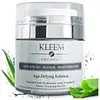Kleem Organics Advanced Retinol Moisturizer Versus Neutrogena Rapid Wrinkle Retinol Regenerating Cream
What's inside
What's inside
 Key Ingredients
Key Ingredients

 Benefits
Benefits

 Concerns
Concerns

 Ingredients Side-by-side
Ingredients Side-by-side

Aloe Barbadensis Sprout
HumectantHelianthus Annuus Flower
Skin ConditioningIsopropyl Palmitate
EmollientPentylene Glycol
Skin ConditioningPhospholipids
Skin ConditioningRetinol
Skin ConditioningPolysorbate 20
EmulsifyingPotassium Phosphate
BufferingPPG-5 Tocopheryl Ether
AntioxidantCassia Angustifolia Seed Polysaccharide
Skin ConditioningGlyceryl Stearate
EmollientCetyl Alcohol
EmollientStearic Acid
CleansingGlycerin
HumectantSimmondsia Chinensis Seed Oil
EmollientCamellia Sinensis Callus
AntimicrobialPropolis Wax
EmollientButyrospermum Parkii Butter
Skin ConditioningPanthenol
Skin ConditioningEthyl Ether
SolventEthylhexylglycerin
Skin ConditioningXanthan Gum
EmulsifyingCitric Acid
BufferingAloe Barbadensis Sprout, Helianthus Annuus Flower, Isopropyl Palmitate, Pentylene Glycol, Phospholipids, Retinol, Polysorbate 20, Potassium Phosphate, PPG-5 Tocopheryl Ether, Cassia Angustifolia Seed Polysaccharide, Glyceryl Stearate, Cetyl Alcohol, Stearic Acid, Glycerin, Simmondsia Chinensis Seed Oil, Camellia Sinensis Callus, Propolis Wax, Butyrospermum Parkii Butter, Panthenol, Ethyl Ether, Ethylhexylglycerin, Xanthan Gum, Citric Acid
Water
Skin ConditioningPentaerythrityl Tetraethylhexanoate
EmollientGlycerin
HumectantDimethicone
EmollientPPG-15 Stearyl Ether
EmollientStearyl Alcohol
EmollientCetearyl Alcohol
EmollientButylene Glycol
HumectantGlyceryl Behenate
EmollientCeteareth-20
CleansingIsohexadecane
EmollientDimethicone Crosspolymer
Emulsion StabilisingCyclopentasiloxane
EmollientCellulose
AbsorbentSodium Polyacrylate
AbsorbentPhenoxyethanol
PreservativeCaprylyl Glycol
EmollientSodium Acryloyldimethyltaurate/Vp Crosspolymer
Emulsion StabilisingPolyacrylamide
C13-14 Isoparaffin
EmollientChlorphenesin
AntimicrobialPolysorbate 20
EmulsifyingHydrolyzed Myrtus Communis Leaf Extract
Skin ProtectingRetinol
Skin ConditioningBHT
AntioxidantSodium Hyaluronate
HumectantDisodium EDTA
Sodium Hydroxide
BufferingLaureth-7
EmulsifyingAscorbic Acid
AntioxidantWater, Pentaerythrityl Tetraethylhexanoate, Glycerin, Dimethicone, PPG-15 Stearyl Ether, Stearyl Alcohol, Cetearyl Alcohol, Butylene Glycol, Glyceryl Behenate, Ceteareth-20, Isohexadecane, Dimethicone Crosspolymer, Cyclopentasiloxane, Cellulose, Sodium Polyacrylate, Phenoxyethanol, Caprylyl Glycol, Sodium Acryloyldimethyltaurate/Vp Crosspolymer, Polyacrylamide, C13-14 Isoparaffin, Chlorphenesin, Polysorbate 20, Hydrolyzed Myrtus Communis Leaf Extract, Retinol, BHT, Sodium Hyaluronate, Disodium EDTA, Sodium Hydroxide, Laureth-7, Ascorbic Acid
 Reviews
Reviews

Ingredients Explained
These ingredients are found in both products.
Ingredients higher up in an ingredient list are typically present in a larger amount.
Glycerin is already naturally found in your skin. It helps moisturize and protect your skin.
A study from 2016 found glycerin to be more effective as a humectant than AHAs and hyaluronic acid.
As a humectant, it helps the skin stay hydrated by pulling moisture to your skin. The low molecular weight of glycerin allows it to pull moisture into the deeper layers of your skin.
Hydrated skin improves your skin barrier; Your skin barrier helps protect against irritants and bacteria.
Glycerin has also been found to have antimicrobial and antiviral properties. Due to these properties, glycerin is often used in wound and burn treatments.
In cosmetics, glycerin is usually derived from plants such as soybean or palm. However, it can also be sourced from animals, such as tallow or animal fat.
This ingredient is organic, colorless, odorless, and non-toxic.
Glycerin is the name for this ingredient in American English. British English uses Glycerol/Glycerine.
Learn more about GlycerinPolysorbate 20 is made by combining ethoxylation of sorbitan, ethylene oxide, and lauric acid. It is a mild cleansing agent, surfactant, and emulsifier.
As a surfactant, it helps collect dirt and oils for washing. Emulsifiers prevent oils and water from separating.
Polysorbate 20 also adds scent to a product. Since it is made using sorbitol, it has a sweet scent. Sorbitol can also be found in fruits such as apples and peaches.
The lauric acid used to create Polysorbate 20 is often derived from coconuts.
Polysorbate 20 may not be fungal acne safe.
Learn more about Polysorbate 20Retinol is a gold-standard ingredient for anti-aging. It is a form of Vitamin A and belongs to the class of retinoids that also includes tretinoin.
Why is retinol famous?
It has the most scientific studies backing up its skin benefits out of all the non-prescription ingredients.
Retinol is proven to:
This is why retinol is effective at removing wrinkles, fading dark spots, treating acne, and reducing the appearance of pores.
Studies show retinol is less effective when exposed to UV. Be sure to look for appropriate packaging to keep your retinol potent (similar to Vitamin C).
Using retinol or any retinoids will increase sun-sensitivity in the first few months. Though studies show retinoids increase your skin's natural SPF with continuous use, it is best to always wear sunscreen and sun-protection.
We recommend speaking with a medical professional about using this ingredient during pregnancy.
Retinol may cause irritation in some people, so be sure to patch test. Experts recommend 'ramping up' retinol use: start using this ingredient once a week and work up to using it daily.
Read about Tretinoin
Learn more about Retinol